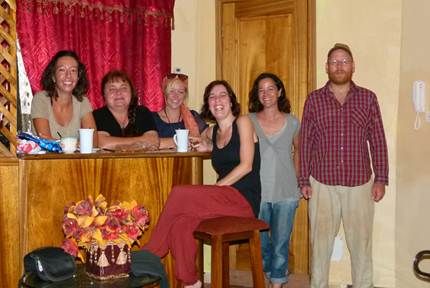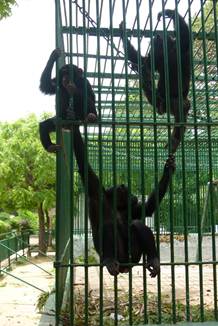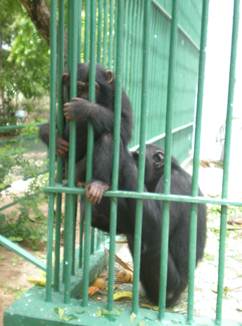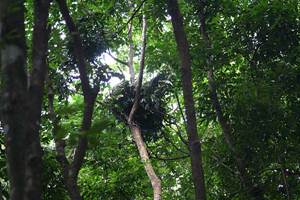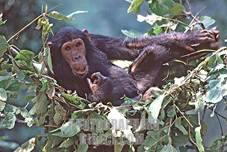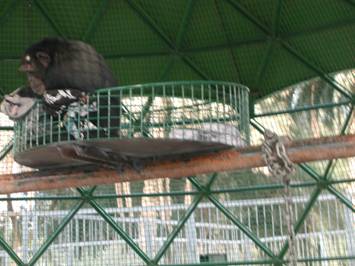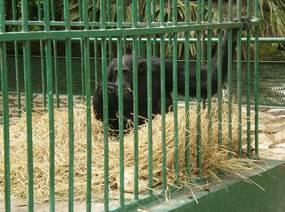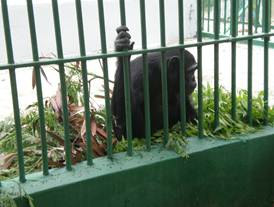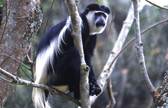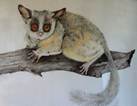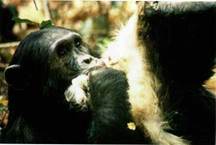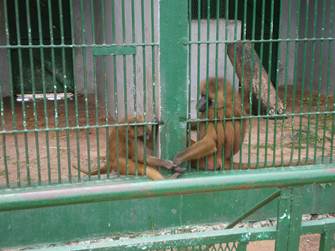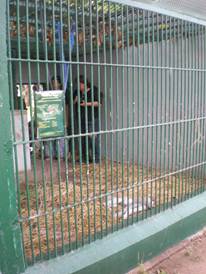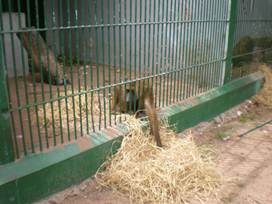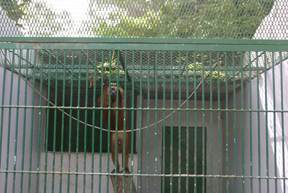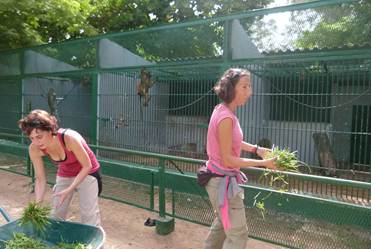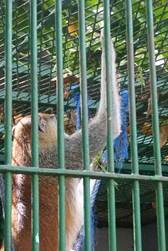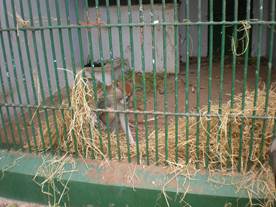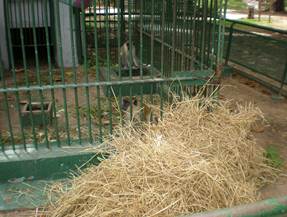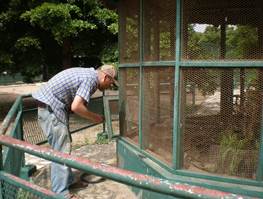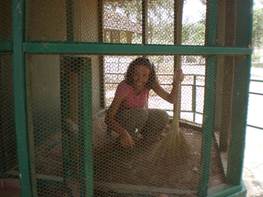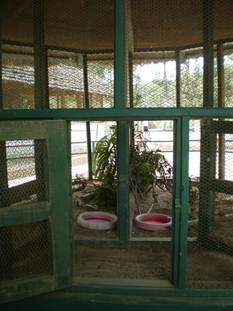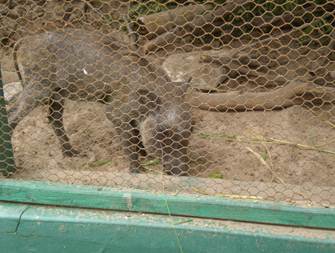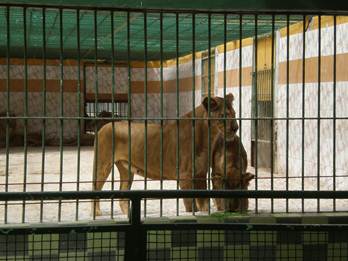
|
Hilda Tresz Global Volunteer Work | ||||||||||
|
|
Senegal | ||
|
From
August 16 through August 24, 2012
Goals:
The
purpose of the visit was to introduce a 6 year old orphan female
chimpanzee to her new surrogate parents; to introduce two
singly-housed male chimpanzees to one another; to introduce any
other singly-housed primates into group settings; to reorganize
basic husbandry routine and start an enrichment plan for all
species.
Contact
person Liliana Pacheco and I worked
closely with Peace Corp Volunteers whose help was invaluable and
appreciated.
Ashleigh Baker, Peace Corp Volunteer Senegal
Patrick Hair, Peace Corp Volunteer Senegal
Paula
Diéguez, IJG Spain- Volunteer and researcher in Goumbambere
Silvia
Casas, IJG Spain- Volunteer
Left
to right: Paula Diéguez, Hilda
Tresz, Ashleigh Baker, Silvia Casas,
Liliana
Pacheco, Patrick Hair Chimpanzees
(Pan
troglodytes verus?)
Pair 1.0 Kou (Kong) 18 years old
0.1
Sydney 12 years old
Solitary
0.1
Edgar 6 years old
1.0
Tali 26 years old
1.0
Movuli 19 years old
With
the exception of the female adult chimpanzee (Sydney) all animals
are possibly P. t. verus. The female looks
quite different, long arms and legs, black face, she could be P.
t. swanfurtii.
Suggestion: Determining taxonomy at the subspecies level would be
desirable. If that cannot be obtained, the use of contraception is
recommended.
There
was only one chimpanzee cage (of the pair’s) prepared for
introductions. All other cages needed doors to connect as well as
some new bars to hold animals.
Unfortunately,
due to different viewpoints and a lack of drugs and working shift
doors, the two single housed male chimpanzees could not be put
together. Mr. Lamine and I will work on this project in the near
future.
The
introduction of an approximately 6 year old female chimpanzee
(Edgar) to surrogate pair was successful. Edgar was raised by
humans and had no species-typical social skills. Initially she was
apprehensive of the adult female chimpanzee but in less than two
days they bonded. Video: http://www.youtube.com/watch?v=Kty1zuudxEU
The
male, once introduced, was extremely gentle with Edgar, constantly
prompting her to play and they appear to be a good family.
Edgar,
Kong and Sydney together.
Sydney grooms Edgar Video: http://www.youtube.com/watch?v=5PbGMRduA4A http://www.youtube.com/watch?v=fyZi7t691HI
Suggestions: Chimpanzees need to be kept in social groups. If
obtaining additional females is not feasible, bachelor parties
need to be created.
Veterinarian Transferring animals from one cage to another was a difficult task due to lack of permanent veterinary staff as well as funds to call a veterinarian and/or immobilize so many chimpanzees at the same time. Suggestion: A veterinarian with permanent status could be secured.
Basic
husbandry
Hay
for substrate, browse for foraging and nest building, logs and
larger branches and a tire for furniture was placed into the
chimpanzee cages. Suggestion: Clean
hay needs to be put into cages every week. Hay can be spot cleaned
daily and replaced at the end of the week, cages need to be hosed
and new hay needs to replace the old. Browse needs to be provided
daily for chimpanzees, especially for nest building. These animals
build a nest twice a day, one for day time and one for
night. Eventually, having them build some type of nest structure
up high in the cages would be desirable since these animals sleep 30-50
Feet high in the wild.
Chimpanzees sleep at incredible heights (30 to 50 Feet / 9.14m to
15.24m) up in the canopy
Chimpanzee with new sleeping basket at the Doha Zoo, Qatar
To further improve quality, permanent and flexible
furniture needs to be installed in each cage. Animals need both to
develop/exhibit proper motor skills.
In most of the enclosures, animals can only use floor space.
Exhibits should utilize three dimensions by adding large tree
trunks, ropes, fire hoses, hammocks, wooden shelves, etc., to
increase space and to the animals’ opportunities for exercise,
exploration and manipulation. Furniture needs to be built from
wood, ropes or any kind of natural materials as opposed to metal.
Sydney
with hay or browse nest.
Diet The
chimpanzees needed diet improvement. Usually they were fed every
second day, more often than not only dry bread and some half
spoiled fruit. They mostly relied on being fed by the visitors.
Diet lacked fresh greens, vegetables, seeds and animal protein
(meat, eggs, milks, and insects).
The chimps at Gombe kill and eat as much as one-third of the colobus monkey
population in the park each year. In West Africa they prey on bush
babies.
This alone was a major scientific find which challenged previous conceptions
of chimp diet and behavior.
http://www.youtube.com/watch?v=WDFh5JdYh7I
http://news.nationalgeographic.com/news/2007/02/070222-chimps-spears.html
Diet usually contains less carbohydrates and fiber in captivity.
u
Fruit
(apples,
oranges, melons, bananas, mangos, berries, etc.)
u
Vegetables
(cabbages, lettuces, cucumbers, carrots, yams, sweet potatoes,
celery, etc.)
u
Browse
(mulberry,
willow, bamboo, tipu, sugar cane, carob, elm, pine, acacia,
mesquite, sissoo, salt cedar, palm fronds, etc.)
u
Commercial
primate diet
(monkey chow)
u
Herbs
(basil,
catmint, lavender, rosemary, etc.)
u
Seeds
(milo,
rice, popcorn, parrot mix, sunflower, nuts, etc.)
u
Tea
(Herbal tea)
u
Fruit
juice
u
Vitamins
and minerals
u
Grains
(bread, cereals, etc.)
To compensate for animal protein:
u
Insects
(mealworms,
wax worms, superworms, grasshoppers, crickets, etc.) and
invertebrates
u
Invertebrates
(snails)
u
Eggs
(chicken,
quail, duck, etc.)
u
Milk
products
(milk, powdered milk, yogurt, etc.)
Suggestions: Due to lack of resources it is understandable that
not all desired food products can be obtained, but the chimpanzees
could receive rice, milk, seeds and hard boiled eggs for protein
every day, 3 times per day. These items are quite cheap and
accessible. Diet needs to be chopped into small pieces and widely
scattered so alpha males would not be able to monopolize desired
food.
Other
species
Guinea baboon
trying to interact.
Patas monkey immobilized and ready for introduction There were many monkeys housed alone such as
Guinea baboon (Papio papio),
patas monkeys (Erythrocebus
patas) and vervet monkeys
(Chlorocebus
pygerythrus).
Due to the zoo not having enough animals to fill the cages and the
Ministry not allowing empty cages, the situation presented some
real problems. However, Mr. Lamine really wanted to make some
positive changes and allowed us to put some animals together. They
are not all in correct social groups yet, however, but at least
are paired up (male-male; male-female, whatever combination we had
available).
Suggestion: Social animals need to be kept with their conspecifics
in correct group setting. There was much debating over the
primates and carnivores current and future welfare. A general
agreement was made that in the future, when the zoo receives
additional animals, they will be paired up.
All cages were filled with substrate, browse and grass.
Since feeders, puzzle feeders or any type of feeding devices were
not available, most primates received grass on the top of their
cage and chopped diet in substrates (hay and browse) at the bottom
of the cages for foraging.
Guinea baboons with new
hay and foraging grass from roof
Paula
and Silvia distributing grass to all primates
Patas
monkey pulling grass off of roof of cage
Patas
and vervet monkeys pulling hay into their cages Common
Warthog (Phacochoerus africanus)
piglet
There
was an unknown aged, suckling warthog piglet found by itself in
very bad shape. Animal was kept in a dark, empty, hot cage and was
fed dry bread and water and had some skin problems. Milk powder
was purchased and animal was fed immediately. We also found a
larger cage with plenty of shade and fixed it up. The animal now
has soil, browse, bark, logs, hay, a wallow and separate dishes
for water and milk.
Patrick
and Paula fixing and old but good cage for the infant warthog
New
cage for baby warthog
Suggestions: the piglet needs to be fed 4xday with milk, seeds,
fresh fruit and vegetables. I left some Hydrocortisone cream for
his skin problem due to no veterinarian care. It needs to be
applied 2xday, please. This is only a temporary treatment and the
animal needs to be examined by a vet please.
Hyenas
There
were some animals that were so old, they could hardly walk. Their
quality of life should be evaluated by a veterinarian. Their cages
are too small, very hot and empty. Hay was placed into all cages.
Keepers were shown to feed hooves and skulls as enrichment.
Video: http://www.youtube.com/watch?v=b507Fi16Hp8 Suggestions: The hyenas should get bones and hooves (besides their
meat) at least 1xweek.
Lions
With
the exception of one of the solitary lions, all animals were kept
in empty cages and on tile floors. In one cage there was a huge
pride kept, while in two separate cages there were two solitary
males.
Suggestions: Lions live in prides in nature and therefore are very
social animals. Some of the females could be taken out of the
group and introduced to the single males. Cage bottoms need to be
broken off and (as Mr. Lamine suggested) planted with grass.
General
propositions: Water
supply for animals
Most
cages only had concrete containers that are not cleaned well or
often. Some animals only get a drink from water bottles maybe
twice a day in this high temperature climate, and have no access
to water at all from late afternoon till next morning. The
chimpanzees learned to ask the visitors to fill their empty
bottles but other animals cannot do the same. Lots of waterers had
no plugs and held no water at all. Animals often only could lick
the wet concrete/tile floor after rain. Please view following
video-chimpanzee drinking from water bottle. http://www.youtube.com/watch?v=_YFUY22y9Tg&feature=player_detailpage
Suggestion: All animals need to have access to drinking water 24
hours a day from automatic waterers and proper furniture. Please
review information regarding Lixit Automatic Dog Waterer for
Outdoor Faucets & Spigots
http://www.gundogsupply.com/-l100-.htm
<http://www.gundogsupply.com/-l100-.htm>
Ear
problems of carnivores. Most carnivores have
only partial ears left due to flies, their ears are continuously
bleeding and infected. Immediate medical care is required please.
Teeth
problems
Most
carnivores seem to have missing teeth or possible teeth problems.
Some lions were very skinny due to not being to able to chew well
anymore and others taking their food.
Suggestions: Animals need to be examined by a vet please. Substrate.
Continuing to keep animals off of hard/ cold/ wet/ dry, unyielding
surfaces (concrete, tile, wood floor, etc.) would be desirable.
The use of appropriate substrate (inside- paper products,
hay, straw, etc.; outside- nonflammable materials such as
sand, soil, mulch, fresh browse, etc.) will make a significant
difference not only in the animals’ health but would improve the
aesthetics of the exhibits. The substrate presentation that
was given to all staff is available for the zoo’s convenience in
French.
Video:
Baboon playing in new sand: http://www.youtube.com/watch?v=SLXvlhJQmfA Browse.
The zoo has large amount of edible vegetation available on grounds
that could provide fresh, leafy branches (browse) at least every
2-3 days but if possible, every day. As mentioned during our
meetings, the zoo could start planting edible trees, bushes
and even crops inside and outside of exhibits, along visitor
pathways and resting areas that will provide future browsing
materials for growing collection demands. Whether cut by staff or
available by natural damage, fallen vegetation can be used rather
than wasted. A step by step instruction (made by our
horticulturist Hassena Kassim) regarding how to trim trees
properly is attached. Suggestions: in order to supply browse the zoo needs to have plant cutting tools such as: Appropriate
social housing.
All animals that are social by nature should be paired up with
their conspecifics. Special
attention needs to be paid to social housing of great apes and
other primates. Please see attached document regarding laws and
regulations for social housing of primates. If animals are
confiscated, they should immediately be introduced into social
groups and an effort to return animals (if from foreign
countries) to their original country should be attempted.
Position for diet preparation.
All
animals (especially in small, unnatural environments) need to be
fed in a way that their foraging time is extended and proper
species-specific behaviors are encouraged. Browse needs to be cut
and distributed as well as all food needs to be chopped. If no
one can be appointed for this position, staff can be scheduled on
a rotation basis.
Keeper
schedule and routine
The keepers seem to be without a daily routine. They were coming in
at different times; sometimes they cleaned exhibits, but sometimes
they did not; they feed randomly; and the animals never seem to
have clean water vessels or cages. It would be desirable to lay
down a set working routine as in most zoos with set hours and a
schedule for daily routine (morning cleaning, feeding, watering,
cleaning ponds, browse and substrates; afternoon checking the
drinking water vessels again, offering toys, preparing enrichment
for next day and doing extended workload, etc.).
Picking
up garbage
(during the day time) should be incorporated into the staff's
daily routine. The zoo has practically
no garbage cans. Local companies can be contacted for donation of
plastic and/or metal kegs and they could be distributed all over
zoo grounds.
Kitchen
area and storage place.
The zoo had no commissary
to prepare food. There was one storage room for dry bread and a
very small room for seeds; otherwise there was no food on grounds.
Many food items were purchased with the Ambassador’s money
(fresh fruit, vegetables, milk, bread, fruit juice, cat chow,
etc.), as well as measuring cups or scoops to help keepers
distributing diet. Food was cut with machetes, only one keeper had
a knife.
Suggestions: A kitchen area needs to be created with at least one
table, some chairs and additional kitchen supplies.
Continuous
education The
following presentations are suggested for further education in
French:
Ø Contra
freeloading at the Phoenix Zoo
(this presentation talks about making animals work for their food
in similar ways as in nature instead of eating diet in short
period of time from metal dishes or rubber tubs
Ø The
beneficial browse (gives
guidelines regarding how to develop a zoo-wide browse program with
numerous browse gardens in the middle of the Sonoran Desert with
no money, and also addresses the major changes that fresh, leafy
greens can make in the animals’ lives)
Ø Let
them be elephants
(addresses the changes we made in our elephants’ lives, how we
helped their behaviors by teaching them how to forage right and
behave like normal females as well talks about basic husbandry,
enrichment ideas and health care)
Ø Rita
chimpanzee, a successful enrichment program at the Doha Zoo, Qatar
(talks
about Rita, who was kept in solitary confinement in an empty cage
all her life but was introduced to her new enrichment program as
well as to a pair of chimpanzees and now happily lives in a small
group setting). Presentations
are available at htresz@thephxzoo.com
Fundraisers
There
were many discussions regarding fundraising opportunities. Mr.
Lamine was provided with several
ideas of how to raise money such as selling/auctioning animal
paintings, foot prints, and painted ostrich eggs, holding
fundraising parties and birthday parties, etc. I also shared our
article about involving the community and volunteers. |
| Program
Information |
| Research
Password
Required
|
|
Education Instruction Manuals ChimpanZoo Data System Guide
|
| Enrichment |
Contact Information
ChimpanZoo
the Jane Goodall Institute
| Global
BWB Secretarial Limited
10 Queen Street Place
London, EC4R 1BE
United Kingdom

